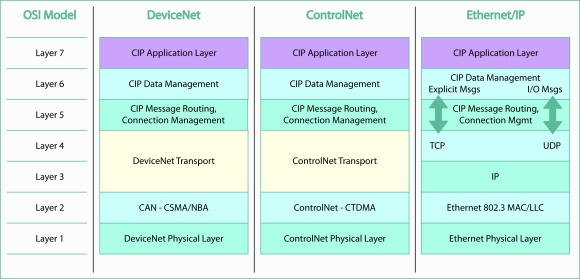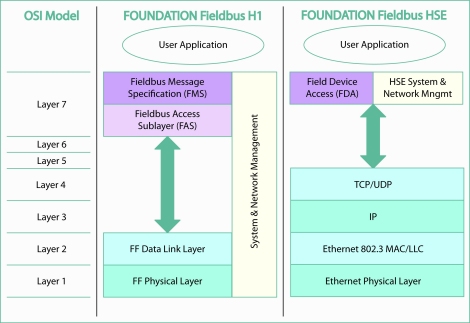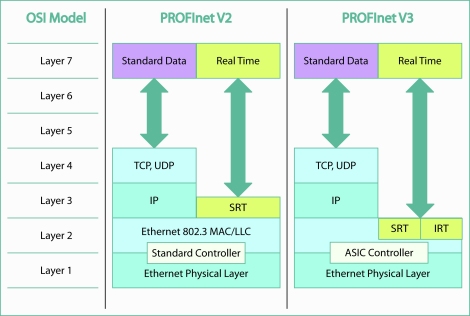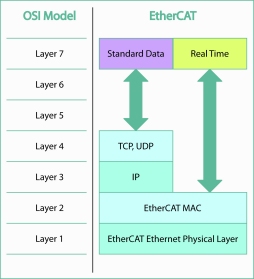Determinism in industrial ethernet:
A technology overview — Part 2
Tuesday, 18 August, 2009
In Part 1 of this article we looked generally at the types of innovations that have been used to make use of ethernet in process plants and factory automation. This month we look at some of the most well-known implementations.
There are something like 20 protocols that can be called industrial ethernet protocols, so an exhaustive description is not possible. We will therefore keep to those most broadly deployed and recognised in international standards.
Modbus/TCP
Modbus was originally developed by Modicon, and today it is managed by the Modbus-IDA User Organization. Modbus is an application-layer messaging protocol, positioned at Layer 7 of the OSI model. It provides client/server communication between devices connected on different types of buses or networks. Modbus-TCP means that the Modbus protocol is used on top of ethernet with TCP/IP via encapsulation.
Modbus-TCP isn't really anything new. It was solely developed to provide ethernet and TCP/IP as an additional data transmission technology for the Modbus protocol, which has been available since 1979. The well-proven Modbus services and the object model that has been available since the original Modbus protocol version are unchanged and have simply been adapted to TCP/IP as the data transmission protocol. This extends the Modbus family with an additional product range, which now consists of the classical Modbus-RTU, Modbus-Plus and Modbus-TCP.
Modbus is a relatively simple request/reply protocol and offers services specified by function codes. Modbus function codes are elements of Modbus request/reply PDUs, and provides a set of functions to read and write data in field devices. Modbus supports bit or word data transfers.
|
|
The performance of a Modbus-TCP network is highly dependent on the type and design of the ethernet network that is used, and on the performance of the communication interfaces of the respective devices.
Ethernet/IP
The Industrial Ethernet Protocol (Ethernet/IP) was originally developed by Rockwell Automation and is now managed by the Open DeviceNet Vendors Association (ODVA). It is a well-established industrial ethernet communication system and has a strong presence in America and Asia, mainly in factory automation applications.
EtherNet/IP uses the encapsulation method, and extends commercial off-the-shelf ethernet by adding the Common Industrial Protocol (CIP) at Layer 7. This same upper-layer protocol and object model is found in DeviceNet and ControlNet. CIP allows EtherNet/IP and DeviceNet system integrators and users to apply the same objects and profiles for plug-and-play interoperability among devices from multiple vendors and in multiple subnets. Combined, DeviceNet, ControlNet and EtherNet/IP promote transparency from sensors to the enterprise software.
|
|
CIP provides a wide range of standard objects and services for access to data and for control of network devices via so-called ‘implicit’ and ‘explicit’ messages. The CIP data packets are encapsulated in standard TCP or UDP packets — the implicit (real-time) messages being carried in the more efficient UDP packets and the explicit messaging carried in connection-oriented TCP packets for configuration and other non real-time functions.
FOUNDATION Fieldbus HSE
The Fieldbus Foundation's High Speed Ethernet (HSE) technology provides a high-speed, plant-wide backbone for process and discrete automation. It integrates FOUNDATION Fieldbus H1 (31.25 kbps) technology for distributed process control applications with a high-speed (100 Mbps) technology through TCP/IP encapsulation. HSE supports the entire scope of the FOUNDATION Fieldbus technology, including standard function blocks and device descriptions, and takes full advantage of the low cost and ready availability of commercial off-the-shelf ethernet components.
The HSE physical layer signalling and data link protocols are specified in the IEEE 802.3 and ISO/IEC 8802-3 standards. However, HSE includes 11 specifications above the ISO seven-layer communication ‘stack’ to meet the requirements of ethernet in industrial applications. The HSE system and network management agents, function blocks, HSE management agents and field device access agents all reside at the user layer, above the application layer of the OSI model.
HSE's use of standard FOUNDATION Fieldbus function blocks, such as AI, AO and PID, ensures a uniform presentation of data at all levels of the control network. The HSE specification assigns a primary time publisher responsible for posting time, and a secondary time publisher that serves a backup in the event of failure by the primary time publisher. The implementation in the network of function blocks that can be shared between devices means that process instruments and actuators can have independent relationships (such as PID loops) that can operate independently of a central controller.
|
|
Being dependent on encapsulation, effectively providing FOUNDATION Fieldbus H1 over an ethernet medium, means that HSE is at this stage designed primarily for expanding the communication and management options in process plants, and not for real-time high-speed factory automation.
PROFInet
PROFInet is the open industrial ethernet standard of Profibus and PROFInet International (PI) for automation. PROFInet uses TCP/IP and IT standards, and is, in effect, real-time ethernet. It takes advantage of both encapsulation and modified ethernet for different applications.
There are two aspects to PROFInet. PROFInet CBA (Component Based Automation) focuses on distributed automation systems. It provides a DCOM-based system for organising automation systems into networks of peer devices. These can automatically exchange data using predefined relationships between the interfaces of the automation components.
PROFInet IO is very similar to Profibus on ethernet. While Profibus uses cyclic communications to exchange data with programmable controllers at a maximum speed of 12 Mbaud, PROFInet IO uses cyclic data transfer to exchange data with programmable controllers over ethernet. In both systems data is organised as slots containing modules, with the total number of I/O points for a system being the sum of the I/O points for the individual modules. PROFInet IO uses three different communication channels to exchange data with programmable controllers and other devices. The standard TCP/IP channel is used for parameterisation, configuration and acyclic read/write operations.
|
|
Within PROFInet IO, process data and alarms are always transmitted in real time. Real time in PROFInet is based on the definition of IEEE and IEC, which allow for only a limited time for execution of real-time services within a bus cycle. The RT communication represents the basis for the data exchange for PROFInet IO. Real-time data are treated with a higher priority than (TCP or UDP) IP data. This type of data exchange allows bus cycle times in the range of a few hundred microseconds.
Isochronous data exchange is also defined in PROFInet. PROFInet IO field devices with IRT functionality have switch ports integrated in the field device. The data exchange cycles are usually in the range of a few hundred microseconds up to a few milliseconds. The difference between IRT and RT communication is essentially the high degree of determinism, so that the start of a bus cycle is maintained with high precision. The start of a bus cycle can deviate (jitter) only up to 1 µs.
EtherCAT
EtherCAT is a real-time ethernet master/slave network developed by Beckhoff, and is an example of how a modified ethernet design can bring ethernet directly to high-speed factory automation devices. EtherCAT can process 1000 distributed I/O in 30 µs or 100 axes in 100 µs using twisted pair or fibre-optic cable. As well as the classic switched star ethernet topology, EtherCAT supports a simple low-cost line structure, a tree structure, daisy chaining or drop lines.
|
The EtherCAT transmission method is modified from standard ethernet at Layer 2 with a special EtherType defined, and special ethernet interface hardware in the devices. With EtherCAT, a standard ethernet frame structure is used, but the frame is no longer received as an individual communication per device. The frame is passed from device to device in a virtual ring, and the EtherCAT slave devices read the data addressed to them while the frame passes through the device. Similarly, input data is inserted while the frame passes through. The frames are only delayed at each device by a few nanoseconds. As an EtherCAT frame comprises the data of many devices in both the send and receive direction, the usable data rate increases to over 90%. The full-duplex features of 100BaseTX are fully utilised, so that effective data rates of greater than 100 Mbps (greater than 90% of two 100 Mbps channels) can be achieved. Direct ethernet frame transfer is used in cases where maximum performance is required and the EtherCAT components are operated in the same subnet as the controller. |
|
EtherCAT can also interoperate with normal TCP/IP-based networks through switches. Any ethernet-based protocol can coexist provided an EtherCAT segment is located at one switch port, and any other ethernet-based communication, such as normal TCP/IP traffic, is located at a different port so as not to interfere with EtherCAT operation.
Gateways and proxies
Although some of the above technologies (such as PROFInet) are capable of providing ethernet-based functionality at all levels of an industrial plant, in most cases plants choose their technologies for different functions for various reasons: technical, historic and economic. Most plants are therefore a mix of different technologies from different vendors.
Luckily, most of the technologies mentioned provide gateway and proxy functionality so that they can be integrated together.
By definition, a gateway is a device or software that incorporates the entire OSI stack from Layer 1 to Layer 7. This allows the true linking of data from not only one protocol to another, but also from one physical network to another – such as between ethernet and serial protocols like DeviceNet or Profibus.
A proxy is also a device that communicates on both networks, and acts as a proxy on one network on behalf of a process on another network.
In the end, the effect is the same — both a gateway and a proxy provide services that map the functions of one network with equivalent functions on the other, and vice versa. The fact that fieldbus vendors provide these gateways is testament to the fact that industrial networks are heterogeneous and will remain so for the foreseeable future.
IO-Link and the role of the IO-Link Master
While it is true that IO-Link is plug-and-play from a hardware perspective, it pays to do your...
Security enhanced for digitalised industrial boilers
Industrial boiler maker Bosch Industriekessel depends on secure gateway technology to offer...
Mineral processing: a eulogy for analog
Leading mines have already accomplished an automated, digitally connected mine and are reaping...













